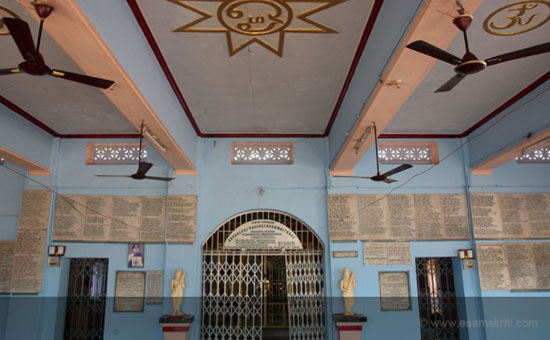- In brief, know about the life and
achievements of Muthuswamy Dikshitar, a gifted musician who lived in the 18-19th
centuries in Tamil Nadu.
Carnatic classical music has always been a vital part of the cultural ethos in South India. There are three extraordinarily gifted musicians in this genre— namely, Thyagaraja, Muthuswamy Dikshitar and Shyama Sastrigal—all of them from Tamil Nadu.
The Trinity of Carnatic music as they
are known, also belonged to the same place Tiruvarur, where the Lord reigns
with His unabated grace, poise and charm, with goddess Kamalambal showering Her
bountiful blessings generously on devotees.
We are fortunate to have had these composers enrich our cultural and civilisational traditions and values, to be cherished and transmitted to future generations as invaluable gifts. Today, all Carnatic musicians are reaping the benefits of the Trinity’s contributions by rendering their hymns and kritis. Legends like M. S. Subbalakshmi, Chembai, Semmangudi, Alathur Brothers, M. L. Vasanthakumari, M. D. Ramanathan, D. K. Pattammal, Lalgudi Jayaraman, Madurai Somu, Madurai Mani Iyer, Kunnakudi Vaidyanathan and many more have rendered these compositions for the benefit of their rasikas.
This
article was first published in the Bhavan Journal.
The three musical geniuses were great devotees too. Thyagaraja’s devotion to Lord Rama was unparalleled. As a result, he received the enviable and rare darshan of Lord Rama with Goddess Sita, Lakshmana and Hanuman. He composed hundreds of keerthanas in various ragas in Telugu and Sanskrit, all woven
through with utmost devotion and piety.
Similarly, the contribution of musical
genius composer Muthuswamy Dikshitar is in no way less from the point of view
of bhakti, melody, richness in
content and illustration of the boundless grace of Gods and Goddesses.
 Inside Thyagaraja Samadhi, Tiruvarur
Inside Thyagaraja Samadhi, Tiruvarur Muthuswamy Dikshitar was born on March
24, 1776 at Tiruvarur and lived almost 60 years. He contributed nearly 500
sublime and magnificent kritis, all
in Sanskrit, praising the grace of gods and goddesses and seeking their
valuable blessings and perennial bliss. Very few know that he was adept at
playing the veena as well.
Just as Saint Thyagaraja moved out of
Tiruvarur to Thiruvaiyaru near Thanjavur, Dikshitar also moved out to Manali
village near Chennai, acceding to the request of Venkatakrishna Mudaliar, a
philanthropist.
There he got the opportunity to watch
and listen to British bands playing western orchestral music at St. George
Fort, Chennai where the Britishers often practised with their army band.
Dikshitar was impressed and fascinated by the Western tunes and melodies, and
went on to compose over 30 simple, hummable kritis in Carnatic music. He named
them as Nottuswaras-English notes
plus swaras. Later the Carnatic
legend Madurai Mani Iyer specialised in singing these notes to enthralled
audiences.
Dikshitar had the unique blessings of
Lord Muruga, the deity of the temple at Tiruttani. It is believed that Lord Muruga
placed a piece of sugar candy in his mouth and commanded him to sing
effortlessly. Thereafter, Dikshitar went on to sing his own melodies, stamping
each with his signature Guruguha.
Surprisingly, Dikshitar started singing as well as playing the veena from the
age of 16 and recited Vedas as well. He enjoyed travelling and visiting
temples, and composed kritis with
rich content on each kshetra,
praising the presiding deities, the temple traditions, local culture and
festivities of those regions.
Dikshitar reached his heavenly abode on
October 21, 1835 at Ettayapuram. Later, his grandson Subbarama Dikshitar
consolidated and compiled his songs in the form of a book in Telugu. Every
year, at the samadhi of Dikshitar at Ettayapuram near Madurai, music enthusiasts
and singers come together to pay tribute to him by singing his evergreen kritis
with utmost devotion.
This year (2024), the 250th birth
anniversary of the musical genius will be celebrated by the classical Carnatic
music fraternity. In March 2024, an NGO named Kural Trust launched an
e-magazine on music and organised a 12-hour marathon event of 70 musicians,
each for 10 minutes, singing his rare and popular kritis in sampradaya style.
In 2022, music enthusiast Ravikiran
launched a mini-documentary series under the banner of Dikshita Kshetra
Darshanam (DKD), enabling music lovers to access all the 500 and odd
compositions of the musical genius. Thus the melodies of Muthuswamy Dikshitar
can be enjoyed and passed on to future generations as a valuable treasure of
our cultural heritage and as a form of musical therapy for those who are in
need of it.
This article was first published in the Bhavan’s Journal, October 1, 2024 issue. This article is courtesy and copyright Bhavan’s Journal, Bharatiya Vidya Bhavan, Mumbai-400007. eSamskriti has obtained permission from Bhavan’s Journal to share. Do subscribe to the Bhavan’s Journal – it is very good.
To read all articles on
Music
Also
read
1. Thyagaraja,
saint poet and musician par excellence
2. Thyagaraja
Temple, Tiruvarur album
3. Four
basic elements of Carnatic music
4. Comparing
Carnatic and Hindustani music